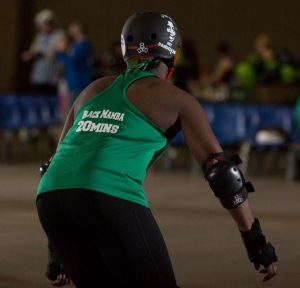Skating in and around other skaters is a learned skill. Before taking the track, we practice this in the form of paceline and pack drills.
Paceline Skills
Paceline Skating
As each person works on their tested paceline skills, all other skaters in the paceline will need to practice keeping a proper paceline moving. Remember what we learned last week:- Stay one arms length behind the person in front of you
- Modify your stride/crossover slightly to keep your feet from kicking the person behind you
- Stay in derby stance
- Use t-stops / snowplows when necessary to slow down
- Use quick feet to speed up when necessary
- If you fall out of line, get back to the line quickly
Paceline Weaving
Weaving through the paceline starts with the rearmost person in the line. The skater will approach one side of the next forward skater and cut in front of them, skate forwards on the opposite side of the next skater and cut in front of them. Progress continues back and forth through the entire line. Things to keep in mind while weaving:- Remember your edges, and cut hard to cross the paceline quickly
- Keep knees soft to keep your balance
- Once you have passed the line, turn your feet back straight so as not to drift away from the line
- Once you have reached the front of the line, you will likely need to slow down (t-stop or snowplow) slightly to match the line’s pace again
Paceline Hip Assists
In a similar weaving pattern as the above drill, we practice our hip assists in the paceline. This is the same skill we practiced last week with a partner:- Approach directly behind
- Grab at the hips
- Pull inwards and then to the side
For skaters in the paceline: be ready in a good derby stance. The hip assisting skater should be slowing you down, so once they pass, pick up your feet to quickstep back to the original pace quickly.
Paceline Hopping
Again, in the same weaving pattern, we hop through the space between skaters in the paceline. Remember the elements of hopping that we learned in Week 3:- By hopping, we mean leaving one foot and landing on the other.
- In order for it to be considered hopping and not stepping, there should be air space under both feet at one moment of time.
- Be sure to take off of a bent knee and land on a bent knee.
Pack Skills
Leaning
Roller derby skaters engage other skaters on the track all of the time. To increase our ability to skate around other skaters and begin making contact, we practice “leaning” while skating with a partner:- Hold the arm closest to your partner across the front of your body, exposing the side of your body.
- Center your balance over the leg closest to your partner.
- Make contact with your partner all of the way from the shoulder to the hip
- Paddle the foot furthest from your partner to keep momentum going.
Shoulder Block
This is the first tested block that we learn. To administer the block:- Skate side by side with the target, no more than one step away.
- Shift your weight from A-frame to centered over the leg closest to the target.
- Move your ribcage towards the target (as opposed to “tipping over”)
- Make contact with the target’s shoulder with your shoulder
Wheel Bumping
Purposefully bumping wheels on the track is not legal, but it can happen. To test a skaters stability, we test reaction to wheel bumping. With a partner, gently “kick” the other’s wheels. Remember that you must be in derby stance for the greatest stability. You may also need to think about engaging your core.Booty Blocking
Booty blocking is also known as positional blocking. The person booty blocking is in front of the person being blocked and attempts to keep them behind by moving side to side. Some tips for success:- Keep watch over one shoulder. If the partner goes out of sight, you will still know that your partner has moved towards the other shoulder. Flipping your head back and forth is a quick way to get faked.
- Stay low, but do not bend over (keep your chest up).
- Feet should be a bit wider than shoulder width, but not too wide that you lose agility with your feet.
- Use snow plow motions to keep the pace slow. If you are able to make contact with your partner, this is ideal. Contact means you not only know visually where they are, but you can feel where they might be going.
- The quickest way to close off space is by leading with the booty.


No comments:
Post a Comment
Leave us a message and we will get back to you as soon as possible.